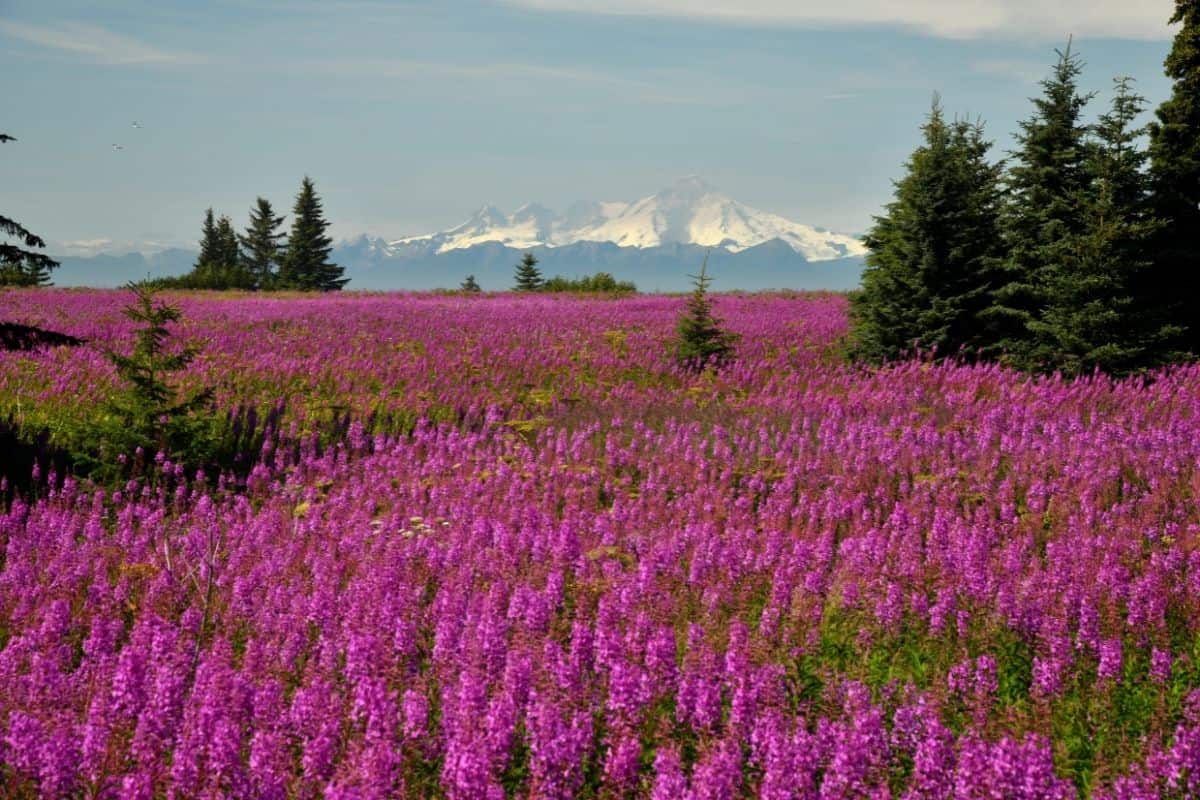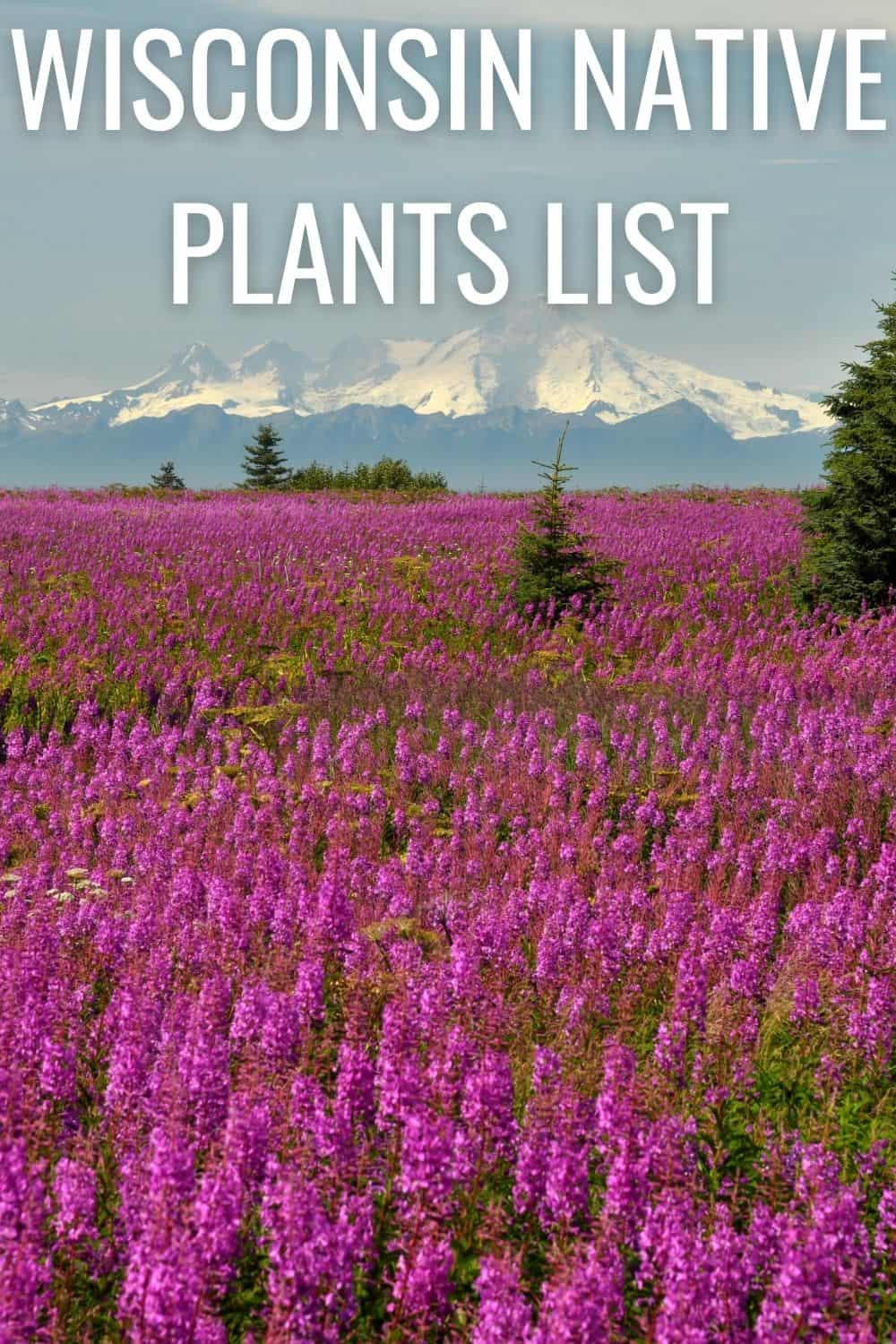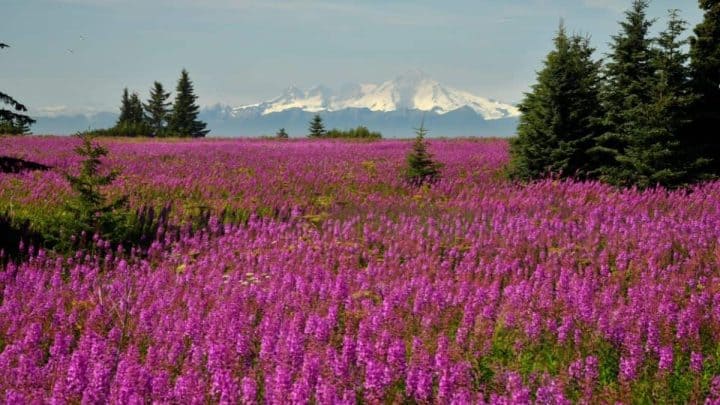Wisconsin is known for Green Bay, cheese, cold weather, and it’s also known for fishing, hunting, snowmobiling, and its Native American culture. In addition to all of this, we know that Wisconsin has some amazing native plant life that you can continue to support by using natives in your gardening projects.
This Wisconsin native plants list will help you see some of our favorite blooming plants that work great for gardening or home landscapes. Keep in mind that Wisconsin is a big state and plants that are native to one area may not be native to another. Do some research into your specific area and zone before you purchase and plant natives. That said, let’s look at the list.

Wisconsin Native Plants List
Here are some native plants to Wisconsin. There are many more to choose from, but these are some that we love based on their flowers and the ease of care.
1. White baneberry (Actaea pachypoda)
White baneberry is also called doll’s eyes because the shiny white fruit looks like eyes that were once used in dolls. The branching stems grow about 1-3 feet tall and have two or three large, compound leaves.
They bloom white from April to June and like moist to wet, acidic, well-draining soil and part shade to full shade. Once established, they are low maintenance and easy to care for.
All parts of this plant are poisonous, but especially the berries and roots.
2. Junebush (Amelanchier arborea)
Junebush is part of the rose family and is known by many names such as common serviceberry, downy serviceberry, shadbush, shadblow, and sarvis. It is typically a tall shrub or a small tree and it’s usually 15-25 feet, although in some cases it can grow as much as 30 feet.
This plant grows masses of showy white flowers that bloom in April and May and later turn into beautiful berries. It prefers moist, well-drained, acidic soil and full sun to part shade.
3. Indigo bush (Amorpha fruticosa)
Another good native flowering plant is the indigo bush. It is sometimes also called false indigo or desert false indigo and it’s part of the pea family. It’s a loose, airy shrub that grows from 6-10 feet on average and will often form dense thickets.
The indigo bush has blooms that can be orange, blue, purple, or violet and they bloom from April to June. They like full sun to part shade and moist soil conditions. They are aquatic and can do well around ponds or water features.
this plant is fast-growing and makes a great ornamental in the garden.
4. Canadian anemone (Anemone canadensis)
Canadian anemone is part of the buttercup family and known by several names including meadow anemone, round-leaf anemone, and windflower. It grows 1-2 feet high and the showy white flowers bloom at the tops of the stems. They have a golden center inside.
It’s a very adaptable plant that can do well in gardens but can also become aggressive, if not kept in check. The flowers bloom from April to June and like moist, sandy soils and part shade to full shade.
5. Eastern red columbine (Aquilegia canadensis)
The bright, showy eastern red columbine is another great option that is native to the area. This plant is known for its very beautiful, unique red and yellow flowers that hang down from the tops of the 2-foot-tall stems.
The flowers grow in a bell shape and bloom from February through July. Not only will these look great in your garden, but they also attract hummingbirds, bees, and other pollinators.
Columbines like dry to moist, well-drained soil and part to full shade. Planting in the continuous sun can stunt their growth.
6. Red bearberry (Arctostaphylos uva-ursi)
Red bearberry is also called kinnikinnick and is part of the heath family. It’s a trailing, evergreen shrub that has beautiful leaves year-round and also blooms clusters of pink or white flowers from March to June.
Typically, the flowers are urn-shaped and waxy, and white in color with just a tinge of pink, although some can be more cream or pink in color. They are drought-tolerant, heat tolerant, and cold tolerant so they can make it through Wisconsin weather, even at its most extremes.
They will attract butterflies and hummingbirds to your garden.
7. Swamp milkweed (Asclepias incarnata)
Next on the list is swamp milkweed. Milkweeds are known for being easy to care for and attracting lots of butterflies and this one is no exception.
Swamp milkweed, as its name suggests, does best in wet, marshy, or swampy conditions. It is also called pink milkweed, for the pink flowers that bloom on it. It grows about 2-4 feet tall, and the pink or purple flowers bloom from June to October.
It will do great in moist soil or in and around a pond and is beneficial to native bees as well.
8. Butterflyweed (Asclepias tuberosa)
Butterflyweed is another variety of milkweed that also attracts butterflies, bees, and hummingbirds to your garden. It is known by many other names including pleurisy root, chigger flower, and orange milkweed.
This bushy plant grows from 1 ½ to 2 feet tall and has large, clusters of flat-topped orange flowers at the tops of the stems. It blooms from May to September and likes dry to moist soil that is well-drained. It can tolerate some drought conditions. It likes full sun and also works nicely as a cut flower.
9. White wild indigo (Baptisia alba)
White wild indigo is also known as white baptisia. It’s part of the pea family and grows from 2-4 feet tall, on average.
The white flowers bloom from April to July. They typically bloom earlier in the south and later in the northern parts.
This plant likes dry to moist, acidic soil and full sun. They are great as ornamental in gardens and grasslands and very beneficial to native bees and bumblebees.
10. American bellflower (Campanulastrum americanum)
American bellflower, or tall bellflower, is a beautiful blue flower in the bellflower family. It grows 3-4 feet tall with leafy stems and the light blue to violet flowers bloom at the tops in clusters.
The purple blooms are stunning and sure to draw attention to your garden. They bloom from June to August and like moist, rich soils and part shade. Direct sunlight will burn them. They can germinate from seed easily.
11. Yellow marsh marigold (Caltha palustris)
Yellow marsh marigold is a simple but beautiful flower. Also known as cowslip, it’s part of the buttercup family and it grows 1-2 feet tall with heart-shaped leaves and a thick branching stem.
The bright, shiny yellow flowers grow at the tops of these stems, above the green leaves. They bloom from April to May and like moist to wet, acidic, humus-rich soil. They like partial to full shade and once established, require very little maintenance.
12. Harebell (Campanula rotundifolia)
Another native choice is harebell, which is actually known by many common names to include bluebell bellflower, witches’ thimble, and bluebell of Scotland. It’s a delicate bellflower with slender stems about 4-15 inches tall.
The blue to violet flowers bloom at the tops and sometimes can weigh the delicate stems down so they lean over. They have the traditional bell shape to them, and they bloom in June through September.
They like dry, sandy, well-drained soils and full sun to part shade and will attract hummingbirds to your garden.
13. Fireweed (Chamerion angustifolium ssp. angustifolium)
Fireweed is another blooming native that makes a strong appearance in a garden or landscape. Also known as willowherb, this member of the evening primrose family is usually 3-5 feet tall and the pink to purple flowers bloom at the tops of those reddish stems from June to August.
They like moist to dry, well-drained soils and full sun. They will attract butterflies and bees to your garden.
They can become weedy in some garden settings and may require some maintenance to keep them looking their best.
14. Partridge pea (Chamaecrista fasciculata)
Partridge pea is also called the sensitive plant and grows from 1-3 feet tall with large, showy, yellow flowers arising from the leaf axils. Each flower has a red mark on it and a narrow pod.
The partridge pea gives a lot of great summer color to your garden and will attract bees and butterflies. They bloom from July to October and prefer dry, deep, well-drained soils and full sun to part shade. They work great as an ornamental or as a border plant.
15. White turtlehead (Chelone glabra)
White turtlehead gets its common name from the shape the flowers make that resembles a turtle’s head. It’s part of the figwort family and grows from 1-4 feet tall on average, blooming in July to September, and likes light, rich, wet to moist soil and full sun to part shade.
They will attract butterflies and hummingbirds to your garden.
16. Sand coreopsis (Coreopsis lanceolata)
Sand coreopsis is part of the aster family and is also known as lanceleaf coreopsis. It usually grows from 1 to 2 ½ feet tall and has leaves that are about 3-4 inches tall.
The yellow flower heads are 1 to 1 ½ inches across. It has yellow disc flowers in the center. They bloom from April to June and this plant likes dry, gravelly soil and full sun to part shade. It’s a great choice for attracting pollinators.
17. Showy tick trefoil (Desmodium canadense)
Showy tick trefoil is part of the pea family and is a unique blooming perennial. Often appearing bushy, it can grow from 2-6 feet tall and has hundreds of pea-shaped rose-colored flowers at the tops of the stems.
The pink and purple flowers bloom from June to September and it likes moist soil and full sun. However, it’s very adaptable and it can also easily take over a garden when conditions are right. It will attract hummingbirds and other pollinators.
18. Purple coneflower (Echinacea purpurea)
Purple coneflower is an absolutely stunning flower that will really pop in your native garden. Part of the aster family, its flowers look like small, purple sunflowers.
The purple coneflower has pink or purple ray flowers on the outside of a purplish disc in the center. They bloom from April to September and are pretty low maintenance. They like dry, well-drained, sandy soil and full sun to part shade.
Butterflies and hummingbirds love these flowers and will come to your garden when you plant coneflowers.
Now that you know about these beautiful garden flowers, you can begin planning your own native garden or landscape.
Native Flowers Of Other States
Wisconsin native plants list FAQ
Here are some commonly asked questions about native plants in Wisconsin.
Where can I buy native plants?
The best places to buy native plants in Wisconsin are from native plant nurseries in your area. You can also look for more information or nurseries near you from Wisconsin Pollinators.
How do I know if I have invasive plants on my property?
If you’re unsure of how to identify them for yourself, you can have an expert come in to “audit” your property. In addition to helping you identify and remove invasive plants, they can also help you determine your soil conditions, climate, and other factors to help decide which native plants will do best in your area.
How do you fight invasive plants with native plants?
Native plants are a great way to fight back against invasive species. You can use high-value native plants that will satisfy ecological needs in the area. You can also compete back with invasive species by using native plants to occupy the space and the soil so that invasive plants can’t move in.
Why use native plants?
Why is it so important and beneficial to use native plants in your gardening? First, native plants play an important role in local ecosystems. They provide food, shelter, and nectar sources for local insects and wildlife. They can also help purify the air and prevent soil erosion.






















Indiana Native Plants List: 21 Low Maintenance Garden Ideas
Monday 10th of April 2023
[…] Wisconsin native plants […]